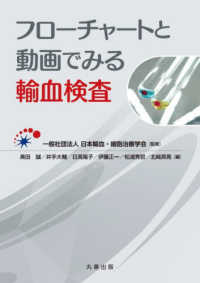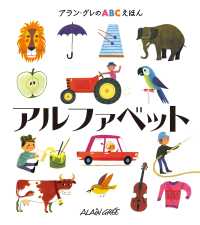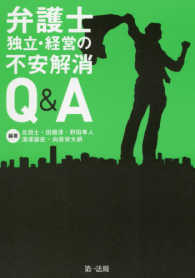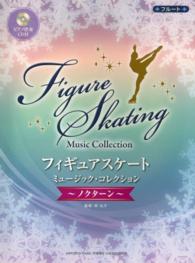Full Description
Diction in Context is a unique and highly practical textbook for singers learning to sing in English, Italian, German, and French. Each chapter is designed for use in diction courses in academic music and voice programs, helping students learn through pronunciation, articulation, enunciation, punctuation, and cultural context in each language.
Students and teachers of singing will benefit from the text's pertinent biographical, historical and literary sources along with diction rules and textual examples of English, Italian, German and French song. For each language, there is a section on sentence structure and syntax intended to assist readers with poetic analysis and word-by-word translations. Representative song texts are provided for the purpose of comparative listening and phonetic transcription. Comparative listening reveals subtle differences in expression and diction. In addition, the texts are presented in a workbook format, allowing space for IPA dictation practice.
Diction in Context provides singers with the tools needed to delve deeply into the poetry and music they sing, to pronounce text accurately and to feel confident in expressing it. By combining English, Italian, German, and French into one easy-to-use textbook, students will benefit from a comparative perspective of singing in each language.
Key Features:
• Repertoire lists are provided for each language and are designed to be used for class presentations and assessments
• Discussion questions to challenge reader comprehension of key concepts and songs
• Word-by-word translations to accompany foreign language texts
• An end-of-book glossary featuring definitions of terms in the text as well as terminology encountered in related literature
• Three practical appendices, including practice drills, quizzes, and assessment forms, and An Index of Works Cited featuring all poems and songs referenced in the book in one easily accessible list
• Access to a PluralPlus companion website with PowerPoint lecture slides, lesson plans, exercises, electronic versions of the appendices and supplementary resources
Contents
Introduction
A Message to Students
A Message to Teachers
Acknowledgements
Reviewers
Chapter 1. Gathering the Tools
Introduction
Meaning
Pronunciation
Articulation
Enunciation
Punctuation
Cultural Context
The Anatomy of Diction
The Mechanics of Diction
Classification of Vowels
Classification of Consonants
Diction and Vocal Health
The Rainbow Passage
Interpretation: Where to Begin
What Do Singers Sing About?
Where Were Songs Sung and Why?
Why Do We Sing as We Do?
How is Love Expressed in English?
What is the Italian View of Love?
How do Germans Interpret the Concept of Love?
Do the French Have Different Views of Love?
Love and the Seasons
Singer's Diction: Poetry in Song
Discussion Questions
Orpheus and His Lyre
Can Poetry Be Defined?
What is Poetry?
Who Writes Poetry, When, and Why?
How Should Poetry Be Read?
How Does a Singer Approach a Poem Set to Music?
Why is Close Reading Important for Singing and Diction?
Discussion Questions
International Phonetic Alphabet: History and Use
Rules of the Road
Essential Vocabulary
Additional Tools
Terms from Greek Mythology and Roman Legend
Literary Symbols
Translations - Literal, "Singable," and Poetic
Rhythm
Rhyme
Symbols
Expressivity of Vowels and Consonants
Literal or "Word-by-Word" Translations
Singable Translations
Poetic Translations/Equivalent
Conclusion
References
Chapter 2. English
The Sounds of English
Singing in English: Why is English Such a Challenge?
Singing in English: How is Singing English different than Speaking English?
The Sounds of English
English Vowel Sounds: The Cornerstones of Singer's Diction
English Consonants
Study Guide: English Consonant Sounds
Practicing Vowel Sounds in English
The Parts of Speech and Elements of Syntax in English
Component Parts of English Sentences
William Shakespeare: The Place to Start in English
Early English Song
Lute Songs and Their Lyrics Defined
Discussion Questions
Diction in Context: Comparative Listening Exercises
English Ayres
John Dowland (1563-1626)
Philip Rosseter (1568-1623)
Thomas Morley (1557-1602)
Early Opera, Oratorio and Airs
Henry Purcell (1659-1695)
George Frideric Handel (1685-1759)
Thomas Arne (1710-1778)
George Munro (1685-1731)
English Diction First Presentation
Repertoire Suggestions
Duet Settings
Poetry and Song in 19th and 20th Century England
William Blake (1757-1823) Poet, Painter and Printmaker
The Brownings: Elizabeth Barrett Browning and Robert Browning
The Rossettis: Christina Rossetti (1830-1894) and Dante Gabriel Rossetti (1828-1882)
Ivor Gurney (1890-1937): Poet and Composer
A. E. Housman: Poet Whose Words Sparked British and American Song
The 19th and 20th Century American Song
The American Approach to Poetic Thought
Emily Dickinson and Walt Whitman
James Joyce and James Stephens
Discussion Questions
English Diction Final Presentation Repertoire List
Conclusion
References
Chapter 3. Italian
The Sounds of Italian
Italian Vowels
Italian Consonants
Diction in Context: Italian Vowels
The Letters "e" and "o"
Diction in Context: Consonants
More About the Letters "c," "g," and "sc"
Double Consonants and Consonant Clusters
Single and Double Consonant Practice
Parts of Speech and Elements of Grammar
Elements of Sentences
Discussion Questions
Italian Language and Thought
Dante and Petrarch
Petrarch and Laura
Early Italian Song
Giulio Caccini (1546-1618)
Marco Antonio (Pietro) Cesti (1620-1669)
Alessandro Scarlatti (1660-1725)
Alessandro Parisotti (1853-1913)
Stefano Donaudy (1879-1925)
Discussion Questions
Italian Diction First Presentation Repertoire List
Italian Vocal Music in the Nineteenth Century
Gioachino Rossini (1792-1868)
Gaetano Donizetti (1797-1848)
Vincenzo Bellini (1801-1835)
Giuseppe Verdi (1813-1901)
Italian Diction Final Presentation Repertoire List
Conclusion
References
Chapter 4. German
The Sounds of German
Single Vowels or Monophthongs
Diphthongs
Glide
Fricative Consonants
Affricative Consonants
Lateral Consonant
Unvoiced Stop Plosive Consonants
Onset of Open Vowels
Parts of Speech and Elements of Grammar
Elements of Sentences
Goethe and Romanticism
Discussion Questions
The Poets
Heinrich Heine (1797-1856): Lyric Poet
Friedrich Rückert (1788-1866)
Joseph von Eichendorff (1788-1857)
Eduard Mörike (1804-1875)
The Composers
Fanny Mendelssohn Hensel (1805-1846) and Felix Mendelssohn-Bartholdy (1809-1847)
Robert Schumann (1810-1856) and Clara Wieck Schumann (1819-1896)
Johannes Brahms (1833-1897)
German Diction First Presentation Repertoire List
Later 19th Century German Lied
Hugo Wolf and Eduard Mörike (1804-1875)
Hugo Wolf and Johann Wolfgang von Goethe (1749-1832)
Hugo Wolf and Joseph von Eichendorff (1788-1857)
Hugo Wolf and Italienisches Liederbuch
Hugo Wolf and Spanisches Liederbuch
Gustav Mahler (1860-1911)
Richard Strauss (1864-1949)
German Diction Final Presentation Repertoire List
Conclusion
References
Chapter 5. French
The Sounds of French
Mute "e": [ə] or [÷]
Glides
"Mixed" Vowels
Nasal Vowels
Diacritical Marks
French Consonants
Parts of Speech and Elements of Grammar
Elements of Sentences
The Early French Art Song
Hector Berlioz (1803-1869)
Cesar Franck (1822-1890)
Charles Gounod (1818-1893)
Composers of the French Mélodie
Camille Saint-Saëns (1835-1921)
Gabriel Fauré (1845-1924)
Who Wrote the Poems that Inspired French Mélodie?
Paul Verlaine (1844-1916)
Victor Hugo (1802-1885)
Charles Baudelaire (1811-1867)
Theophile Gautier (1811-1872)
Claude Debussy (1862-1918)
Ernest Chausson (1855-1899)
Henri Duparc (1848-1933)
Emmanuel Chabrier (1841-1894)
Reynaldo Hahn (1875-1947)
Discussion Questions
The French mélodies of Maurice Ravel, Francis Poulenc, and Erik Satie
Maurice Ravel (1875-1937)
Francis Poulenc (1899-1963)
Erik Satie (1866-1925)
French Diction Final Presentation Repertoire List
Conclusion
References
Concluding Thoughts
Glossary
Appendix A. Practice Drills, Quizzes, Assessment Forms
Appendix B. Index of Works Cited
Appendix C. Resources for Diction Learning
Index








